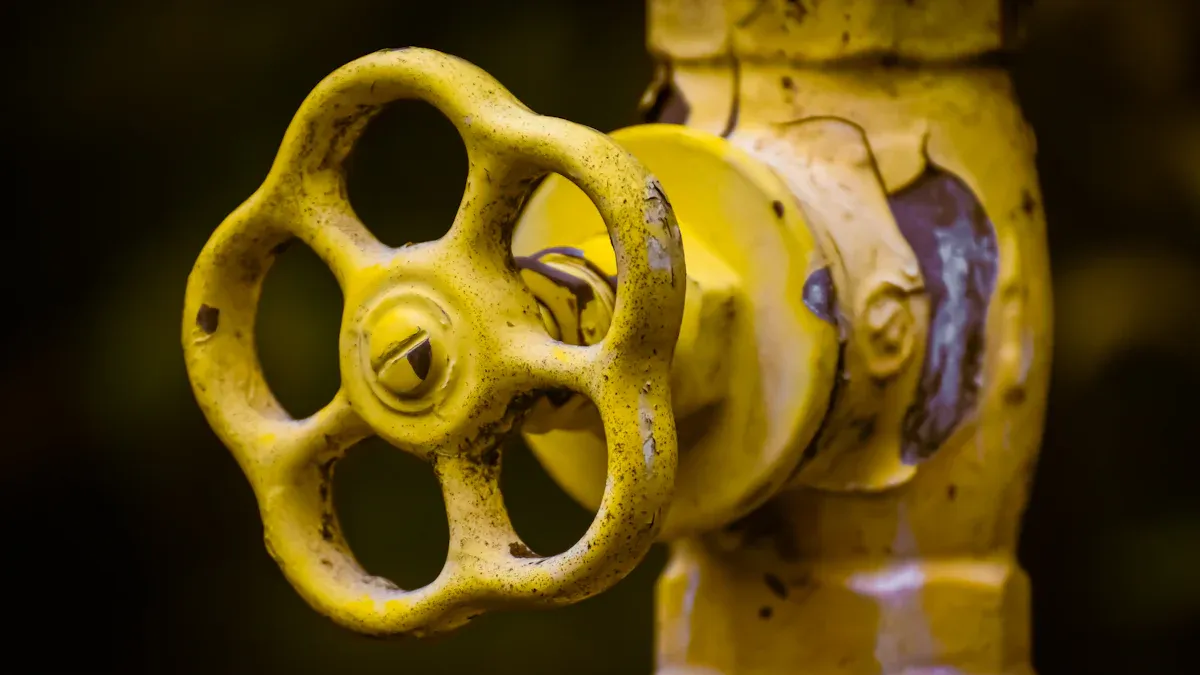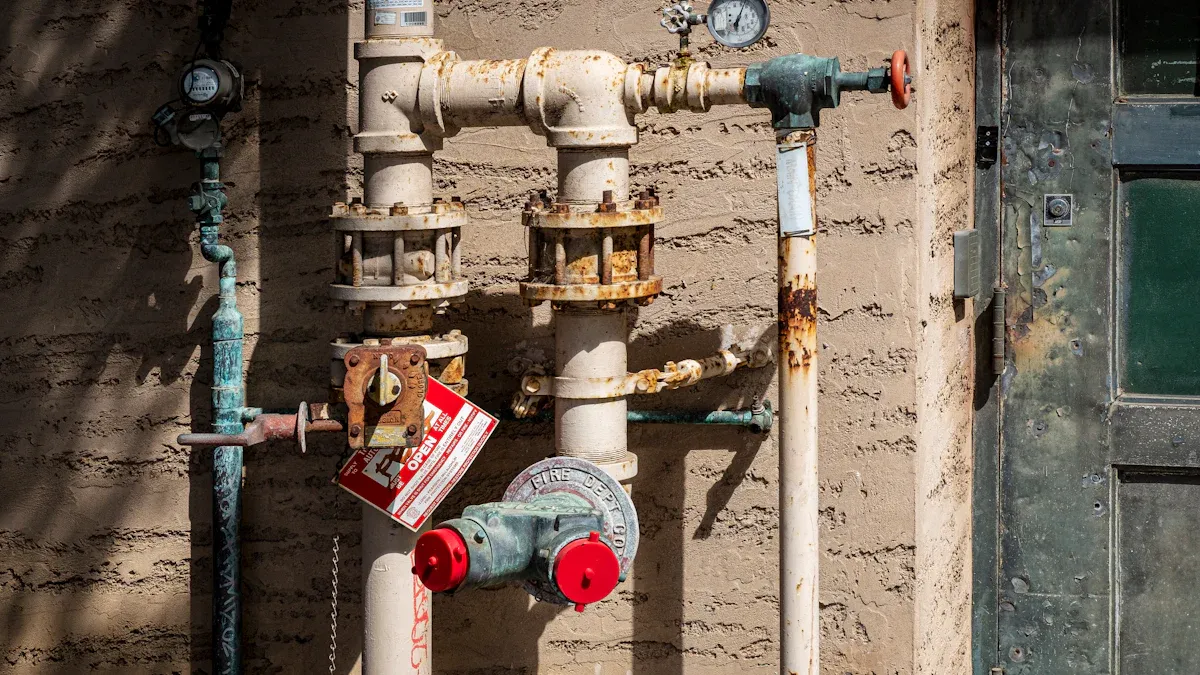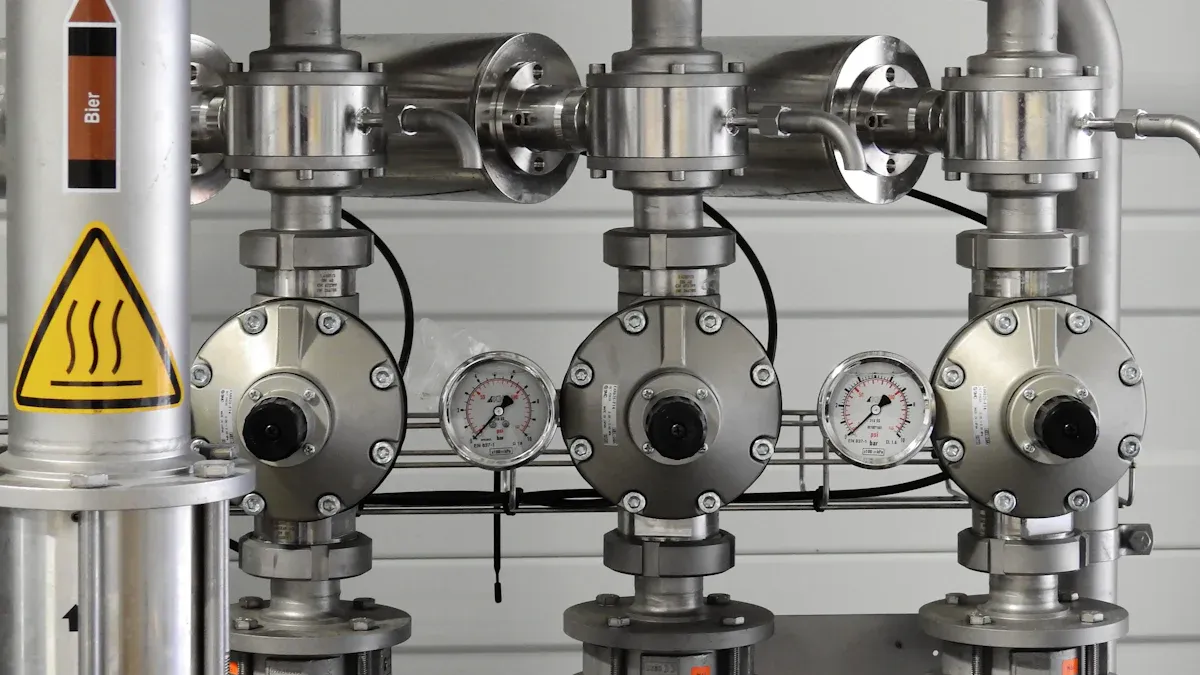
Solenoid valves play a critical role in controlling fluid flow across industries. Their efficiency directly impacts operations in automotive, manufacturing, and HVAC systems. The global solenoid valve market is projected to grow from USD 4.5 billion in 2023 to USD 7.8 billion by 2032, with a CAGR of 6.3%. For instance, the 12/24V Fuel Solenoid Valve 6630546 6632196 For 843 ensures precise fuel control in heavy machinery. Similarly, the electromagnetic valve for Elantra electromagnetic enhances vehicle performance. Proper maintenance safeguards these components, reducing downtime and extending their lifespan.
Key Takeaways
- Cleaning and checking solenoid valves often makes them last longer.
- Following a set maintenance plan finds problems early and saves money.
- Using new tools and smart methods improves valves and helps the environment.
Understanding Solenoid Valves

What Are Solenoid Valves?
A solenoid valve is an electromechanical device that controls the flow of liquids or gases in a system. It operates by converting electrical energy into mechanical motion, enabling precise control over fluid dynamics. These valves are integral to automation systems, where they regulate processes in industries such as manufacturing, automotive, and HVAC. According to technical documents, solenoid valves are also pivotal in reducing energy consumption and enhancing safety compliance in specialized equipment.
| Document Title | Description |
|---|---|
| Solenoid Valves | Overview of solenoid valves and their applications in automation systems. |
| New valve technology enables lower-energy consumption in OEM equipment | Discusses advancements in solenoid valve technology aimed at reducing energy consumption. |
| Valve performance and safety rating improves fire safety equipment | Case study on the performance of solenoid valves in fire suppression systems. |
| Flawless Performance with a Side of Safety Compliance | Case study on the use of solenoid valves in commercial food steaming equipment. |
Key Components of a Solenoid Valve
The functionality of a solenoid valve depends on its core components, which work together to regulate fluid flow. These include:
- The power source, typically an AC or DC supply, which energizes the system.
- The valve body, housing an actuator arm that opens or closes based on solenoid signals.
- The solenoid, which converts electrical signals into mechanical motion to control airflow.
How Solenoid Valves Work
Solenoid valves operate by leveraging electromagnetic principles to control fluid flow. When an electric current passes through the solenoid coil, it generates a magnetic field. This field interacts with a plunger or piston, causing it to move. The movement either opens or closes the actuator arm, regulating the flow of liquid or gas.
Their performance under varying pressure conditions is critical. Research highlights key operational characteristics:
| Characteristic Point | Description |
|---|---|
| Start of Closing Time | The point at which the solenoid valve begins to close, affecting fuel pressure. |
| Fully Closed Time | The point when the solenoid valve is completely closed, stabilizing fuel pressure. |
| Start of Opening Time | The moment the solenoid valve starts to open, initiating changes in fuel pressure. |
| Fully Opened Time | The point at which the solenoid valve is fully open, allowing maximum fuel flow. |
| Prediction Validation | The predicted displacement curves closely match experimental results, with a relative error of 3%. |
By understanding these principles, operators can ensure solenoid valves function efficiently in diverse applications.
Common Problems with Solenoid Valves
Failure to Open or Close
A solenoid valve may fail to open or close due to mechanical or electrical issues. Common causes include dirt or debris obstructing the actuator, insufficient power supply, or a damaged coil. For example, a refrigeration system experienced continuous cooling because the valve remained stuck open. Initial assumptions pointed to dirt or wiring issues, but real-time monitoring revealed a manufacturer defect. This case highlights the complexity of diagnosing such failures.
| Study Title | Description |
|---|---|
| Predicting the useful life of Solenoid valves | This study focuses on predicting the remaining useful life of solenoid valves using data-driven methods to enhance maintenance decisions. |
| Early Detection of Coil Failure | This research isolates fault-induced changes in coil resistance to detect early signs of coil failure without special equipment. |
| Failure Mechanism Study of Solenoid Valves | This study uses thermal-structure finite element methods to analyze failure mechanisms related to thermal expansion in solenoid valves. |
Coil Malfunctions
Coil malfunctions often result from overheating, electrical surges, or wear over time. These issues can reduce the force-to-friction ratio (FFR), which is critical for reliable operation. In low-power applications, the FFR may drop to as low as 6, far below the safety threshold of 10. High spring force is essential to counteract friction and ensure the valve operates correctly. Poppet valves, with their simpler design, are often more reliable than spool valves due to fewer failure points.
Leakage Issues
Leakage in solenoid valves can occur when seals degrade or foreign particles damage the valve seat. This problem not only reduces efficiency but also poses safety risks in systems handling hazardous fluids. Regular inspection and timely replacement of seals can mitigate leakage. Operators should also ensure that the valve is installed correctly to prevent misalignment, which can exacerbate this issue.
Sediment and Corrosion
Sediment buildup and corrosion are common in solenoid valves exposed to harsh environments or poor-quality fluids. These factors can obstruct fluid flow and damage internal components. Preventive measures, such as installing filters and using corrosion-resistant materials, can significantly extend the valve’s lifespan. Routine cleaning and maintenance further reduce the risk of sediment accumulation.
Maintenance Tips for Solenoid Valves

Cleaning and Inspecting Components
Regular cleaning and inspection are essential for maintaining the efficiency and longevity of a solenoid valve. Proper maintenance begins with safety precautions. Disconnect the power supply and depressurize the system to avoid accidents. Once the system is safe, inspect the coil for cracks or signs of burnout. Damaged connections should also be checked and repaired promptly.
Internal components, such as the valve stem, seals, and springs, require thorough cleaning. Use a clean cloth and running water to remove debris and deposits. After cleaning, inspect these parts for wear or damage. Replace any components that show significant deterioration. Reassemble the valve following the manufacturer’s guidelines and test it for proper functionality. Keeping a detailed maintenance log ensures future reference and helps track the valve’s condition over time.
Preventing Sediment and Corrosion
Sediment buildup and corrosion are common issues that can compromise the performance of solenoid valves. Preventive measures play a crucial role in avoiding these problems. Regular maintenance routines help identify and address early signs of sediment deposition. Cleaning the valve thoroughly during each maintenance cycle prevents debris accumulation.
Environmental factors and fluid quality significantly impact corrosion rates. Using corrosion-resistant materials and installing filters can minimize exposure to harmful elements. A well-planned maintenance schedule tailored to the valve’s operating conditions ensures consistent performance and reduces the risk of costly repairs. Troubleshooting common valve problems during routine checks also helps prevent long-term damage caused by sediment and corrosion.
Establishing a Maintenance Schedule
A structured maintenance schedule is vital for ensuring the reliability of solenoid valves. The frequency of maintenance depends on factors such as usage intensity, environmental conditions, and the type of fluid being controlled. High-usage systems or those operating in harsh environments may require more frequent inspections.
Operators should document maintenance activities, including cleaning, inspections, and component replacements. This record helps identify patterns and predict potential issues before they escalate. Scheduling maintenance during planned downtimes minimizes disruptions to operations. A proactive approach to maintenance not only extends the valve’s lifespan but also enhances overall system efficiency.
Checking Electrical Connections
Electrical connections are critical to the proper functioning of solenoid valves. Loose or corroded wires can lead to erratic operation or complete failure. Regularly examining these connections ensures the system operates smoothly. Testing the solenoid coil for continuity verifies its functionality and helps identify potential issues early.
A maintenance routine should also include verifying that the valve is free from obstructions and lubricating moving parts to reduce wear. Tightening electrical connections prevents operational issues caused by poor contact. These steps, when performed consistently, contribute to the long-term reliability of the solenoid valve and the system it supports.
Troubleshooting Solenoid Valves
Verifying Power Supply
A reliable power supply is essential for the proper functioning of a solenoid valve. Technicians should begin by confirming that the correct voltage is being delivered to the valve’s electrical actuators. Voltage mismatches or interruptions can lead to erratic behavior or complete failure.
To ensure the power supply is effective, follow these diagnostic benchmarks:
- Verify that the voltage matches the specifications outlined in the valve’s manual.
- Inspect supply lines for loose connections, leaks, or blockages that could disrupt performance.
- Check for any interruptions in the power source, such as blown fuses or tripped circuit breakers.
Addressing power supply issues promptly can prevent further damage to the valve and the system it supports.
Cleaning Internal Parts
Internal cleaning is a critical step in troubleshooting solenoid valves, especially in systems prone to contamination. Over time, biofilm and debris can accumulate inside the valve, obstructing fluid flow and reducing efficiency. Studies have shown that solenoid valves in non-touch sensor taps often exhibit higher levels of biofilm contamination compared to other components.
Effective cleaning involves the following steps:
- Disconnect the valve from the power supply and depressurize the system to ensure safety.
- Remove the valve from its housing and disassemble it according to the manufacturer’s guidelines.
- Use a soft brush or cloth to clean internal parts, paying special attention to areas with visible deposits.
- Rinse components with clean water and allow them to dry completely before reassembly.
Regular cleaning not only restores the valve’s functionality but also prevents long-term damage caused by sediment buildup.
Replacing Damaged Components
When cleaning and basic troubleshooting fail to resolve issues, replacing damaged components may be necessary. Technicians should inspect the valve for signs of wear, such as discoloration on the coil or cracks in the seals. In a documented case at a water treatment facility, replacing aged coils and implementing a cleaning schedule improved system stability by 30%.
Key steps for replacing components include:
- Identify the damaged part and consult the manufacturer’s documentation for replacement instructions.
- Ensure that the replacement part matches the valve’s specifications, including voltage ratings and material compatibility.
- Install the new component carefully, following the recommended torque settings to avoid over-tightening.
- Test the valve after reassembly to confirm that it operates correctly.
Proactive replacement of worn parts can extend the lifespan of the solenoid valve and enhance overall system reliability.
Ensuring Safety During Troubleshooting
Safety should always be a priority when troubleshooting solenoid valves. Collecting failure data helps technicians understand common failure rates and identify potential hazards. Familiarity with industry standards, such as those from the National Fire Protection Association (NFPA) and the International Electrotechnical Commission (IEC), ensures that valves are selected and maintained appropriately for their applications.
To maintain safety during troubleshooting:
- Always disconnect the power supply and depressurize the system before beginning any work.
- Use personal protective equipment (PPE), such as gloves and safety glasses, to minimize exposure to hazardous materials.
- Follow guidelines from standards like IEC 61511, which emphasize the importance of reliability data in validating designs for Safety Instrumented Systems (SIS).
Adhering to these safety protocols protects both the technician and the system, ensuring a secure and efficient troubleshooting process.
Advanced Repair Techniques
Managing Complex Repairs
Complex solenoid valve repairs often require a systematic approach to ensure success. Technicians should begin by isolating the problem through detailed diagnostics. Advanced tools, such as multimeters and pressure gauges, can help identify electrical or mechanical faults. For example, a multimeter can measure coil resistance to detect potential short circuits.
Tip: Always document each step during the repair process. This practice helps track progress and ensures no critical detail is overlooked.
When addressing intricate issues, such as internal component misalignment, technicians should disassemble the valve carefully. Using precision tools minimizes the risk of damaging sensitive parts. After repairs, reassemble the valve according to the manufacturer’s specifications and test it under controlled conditions to verify functionality.
Using Manufacturer Documentation
Manufacturer documentation serves as an invaluable resource during repairs. These guides provide detailed instructions, diagrams, and specifications tailored to the specific valve model. Technicians should consult these documents to ensure proper handling and compatibility of replacement parts.
| Document Type | Purpose |
|---|---|
| Installation Manuals | Provide step-by-step setup instructions. |
| Maintenance Guides | Outline cleaning, inspection, and troubleshooting procedures. |
| Technical Specifications | Detail operational parameters, such as voltage and pressure tolerances. |
Following these resources reduces the likelihood of errors and ensures compliance with industry standards.
Knowing When to Seek Professional Help
Certain repairs may exceed the expertise of on-site technicians. In such cases, seeking professional assistance ensures the valve is restored to optimal condition. Indicators that professional help is needed include recurring failures, extensive internal damage, or the absence of specialized tools.
Note: Partnering with certified repair services can save time and prevent costly mistakes. Professionals often have access to advanced diagnostic equipment and proprietary replacement parts.
Recognizing the limits of in-house capabilities protects the system from further damage and ensures long-term reliability.
Preventive Measures for Solenoid Valves in 2025
Modern Maintenance Tools
Modern tools have revolutionized solenoid valve maintenance, making it more efficient and precise. Digital multimeters and portable diagnostic devices allow technicians to measure coil resistance and detect electrical faults quickly. Ultrasonic cleaning systems have also become essential for removing sediment and biofilm from internal components without causing damage. Additionally, mobile apps now provide real-time monitoring and maintenance alerts, enabling operators to address issues before they escalate. These tools not only save time but also reduce the risk of costly repairs.
Advances in Solenoid Valve Technology
Recent innovations in solenoid valve technology have significantly improved performance and sustainability. For instance, the Neles NDX 2.0 intelligent valve controller reduces air consumption by up to 90% compared to traditional valve positioners. This advancement lowers energy use and CO2 emissions, aligning with global sustainability goals. The NDX 2.0 also enhances control accuracy, leading to better process quality and increased profitability. Valmet’s online calculator further empowers users to estimate potential energy and cost savings based on their specific operational parameters. These advancements highlight the industry’s commitment to efficiency and environmental responsibility.
Predictive Maintenance Strategies
Predictive maintenance strategies have become indispensable for ensuring solenoid valve reliability. By leveraging sensors and IoT technology, operators can monitor valve performance in real time. Data analytics tools analyze this information to predict potential failures, allowing for timely interventions. For example, vibration sensors can detect early signs of mechanical wear, while temperature sensors identify overheating issues. Predictive maintenance not only minimizes downtime but also extends the lifespan of solenoid valves, ensuring uninterrupted system performance.
Maintaining and troubleshooting solenoid valves ensures system reliability and reduces operational costs. Regular inspections, cleaning, and predictive maintenance extend their lifespan.
Tip: Adopting these practices minimizes downtime and enhances efficiency. Operators who prioritize proactive care will achieve consistent performance and long-term savings.
Investing in modern tools and strategies safeguards critical systems and supports sustainable operations.
FAQ
What is the lifespan of a solenoid valve?
The lifespan depends on usage, maintenance, and environmental conditions. With proper care, most solenoid valves last between 5 to 10 years.
Can solenoid valves handle high-pressure systems?
Yes, many solenoid valves are designed for high-pressure applications. Always check the manufacturer’s specifications to ensure compatibility with your system’s pressure requirements.
How often should solenoid valves be inspected?
Routine inspections should occur every 6 to 12 months. High-usage systems or harsh environments may require more frequent checks to ensure optimal performance.
Tip: Regular maintenance and timely repairs significantly extend the lifespan of solenoid valves.
Post time: Apr-24-2025
